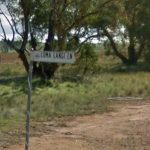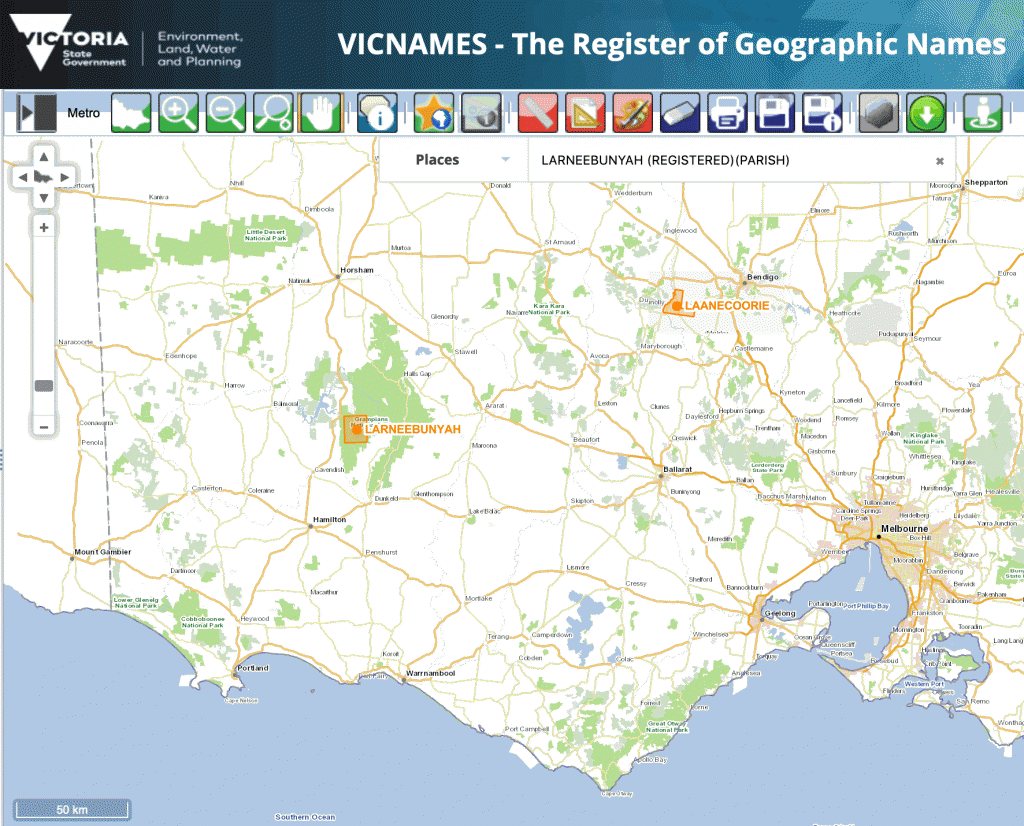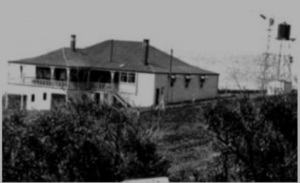Owners have commonly bestowed a name on their property, whether it be a residence in town, a homestead, a boat. Since at least the late 19th century in Australia, a popular source for these names has been some of the vocabulary of Australian languages and other languages of the region. The demand has been met in the last century by various popular booklets of ‘Aboriginal names’ (referenced in previous posts on Orana and on Akuna). Before those booklets began to be published, newspapers and magazines published suggestions, sometimes drawn from the Collectors of Words notably the books of Brough Smyth (1878) and Curr (1886/7).
Particularly in the southeast of Australia, an influential source was the contribution of Alexander Cameron Macdonald (1828–1917), ‘accountant, surveyor and geographer’:
Mr. Macdonald, who was in his 89th year, had made the language and lore of the Australian black his hobby; he had studied his ways, knew his language, and understood, him as few men have. He had a vocabulary of many thousands of native names and their English equivalents. He loved his subject, and by papers and pamphlets read before the Royal Geographical Society and the Historical Society served to disseminate his knowledge. It was, however, as a contributor to “The Australasian” and by the answers he supplied in its columns to questions requiring familiarity, with aboriginal languages and dialects that he became so widely known. For the last 30 years it was rare for a week to pass without his name appearing in the “Notes and Answers” column. It was all a labour of love with him. (Obituary, Australasian (Melbourne))
This post takes a look at just two of Macdonald’s suggestions, Loma Langi and Loma Larnee.

writes Mr. A.C. Macdonald. … “Loma Langi,” in the Fijian language, means “Heaven,” or “home of love.” NOTES & ANSWERS. The Australasian (Melbourne) 9 November 1907:37
“Bungalow.”—Mr. A.C. Macdonald advises that any of the following aboriginal names would be suitable for a bungalow at the seaside:—”Loma Larnee,” signifying “Heaven, or the home of love;” “Carinyah,” “a happy, peaceful home, where no quarrels are allowed to come; “Mie Gunyah,” “my home;” “Kooyong,” a beautiful locality;” “Wahroonga,” “our home.”
NOTES & ANSWERS. The Australasian (Melbourne) 21 April 1917:23
The newspaper evidence in Trove shows that Loma Langi has been quite popular and widespread. The earliest occurrence is in Brisbane in 1907, a few months before Macdonald’s note, so it wouldn’t’ve been the only source.
In contrast, there are only a few Loma Larnee to be found, the earliest contemporary with Macdonald’s published suggestion:
- Loma Larnee holiday house (now a heritage property) built 1916-17 by the Bingley family at 45 Harvey Street, Anglesea (southwest of Melbourne), with the name also applied to their recreational boat (( ‘”Loma Larnee” at 45 Harvey Street has significance is a rare, more substantial example of a Late Edwardian style in Anglesea. Built in 1916-17 as the holiday home for Arthur and Elsie Bingley of “Warrambeen”‘ pp.4-5 in Dr David Rowe (Authentic Heritage Services Pty Ltd) & Wendy Jacobs. Surf Coast Shire Heritage Study Stage 2B. July 2009. )), (( “REGATTA AT ANGLESEY.” Geelong Advertiser 4 January 1922: 3 )), (( Sir and Mrs A.P. Bingley and Mr H.C. Bingley are once more at “Loma Larnee.” “OUR SEASIDE RESORTS” Geelong Advertiser 19 December 1928:5 ))
- Loma Larnee farm, Bulgandry, southern NSW “Family Notices” Table Talk (Melbourne) 13 September 1923: 13
- Loma Larnee house, Crisp St, Wangaratta “Family Notices” The Argus (Melbourne) 3 January 1942:5
- Loma Larnee poultry farm, Tarraganda (inland from Bega, southeast NSW) Bega District News 6/06/2003 (( ‘Wayne Galli of Tarraganda is following a tradition set by his great great uncle, Bill Reilly, who married Edie Pearce and farmed at “Loma Larnee”, Tarraganda, where he raised quality poultry and became a prominent judge of the feathered breeds.’ snapshot 26 October, 2009 ))
Note that all four locations are in the reach of the Melbourne newspaper.
Now, as Macdonald stated, Loma Langi is from Fijian lomālangi ‘sky, heaven’: (( lomalagi ‘sky, heavens’ Ronald Gatty 2009:146 Fijian-English Dictionary; note also lomana v. ‘to love in the sense of caring for, feel for’ which Macdonald may have also known ))
Conventional Fijian spelling is lomālagi, but g represents ng [ŋ] as in English sing. The macron in ā marks the vowel as long. Stress pattern is [‘lo’maː’laŋi].
The probable etymology of lomālagi is loma-a-langi ‘inside-linker-sky’. langi is ‘sky’ in Polynesian languages. In Fijian langi no longer occurs alone, but only in the compound lomālangi. The ‘heaven’ sense was added after the missionaries came. (p.c., Andrew Pawley)
What about the origin of Loma Larnee?
One possibility is that it is a deformation of lomālangi by English speakers, either from confusing /ŋ/ with /n/, or perhaps intentionally respelling to avoid the incorrect pronunciation with an intrusive stop [‘laŋgi].
And there’s another contributing factor : the words larnee ~ larr-nee and larr ‘house’ recorded by Joseph Parker in Ja-jow-er-ong (Djadjawurrung, Dja Dja Wurrung), a language of central west Victoria, published in Brough Smyth 1878. (( Parker, Joseph. 1878. Dialect of the Ja-jow-er-ong race, Brough Smyth II:154-65 at https://aiatsis.gov.au/collections/collections-online/digitised-collections/collectors-words/robert-brough-smyth/word-lists-robert-brough-smyth a substantial vocabulary of 750 words and half a dozen sentences )) The word larnee is derived from lar ‘camp, dwelling’ with -ni an allomorph of the Locative/Allative suffix (( -i, -ni, -yi, Blake 2011:32; r represents a glide like Australian English r )) , and occurs in the compounds larr-nee-kap-pang ‘south-west (literally ‘house of the snow’) and larr-nee-ghyrre ‘bladder’ (with ghy-rre ‘urine’), and placenames Larneparramul ~ Laane-Pyramul ‘home of the emu’ (parimal ’emu’) (near Franklinford north of Daylesford, Blake 2011:11), Laanecoorie (a parish 30km west of Bendigo) (( kurre ‘kangaroo’ Blake 2011:116; Laane-coore ‘home of the kangaroo’ E.I. Watkin 1914:16 Australian native words and their meanings. (Melbourne: Sydney J. Endacott) )) and Larneebunyah (a parish in the Southern Grampians Shire; see map below from VICNAMES). (( Also “Jenep (djinab) the Sulphur Crested Cockatoo exists as a placename near the Yarriambiack Creek and ‘larnee jinnep’ – his landing place or more literally his camp lies further west.’ p.293 (PDF p.307) in E. Ryan ‘Water for country, words for water: Indigenous placenames of north-west Victoria and south-west New South Wales’ Chapter 16 pp.287- in Indigenous and Minority Placenames 2014 ))

By a curious coincidence, the second part of Loma Langi can also be related to another Victorian word Langi ‘Home or dwelling-place’. (( p.195 in the composite list by the Surveyor-General of Victoria, Brough Smyth 1878:192-204; and in vocabulary 203 ‘Kulkyne’ Curr 1886 III:454-5 ; reconstitutions in bold from Blake 2011 )), also occurring in placenames Langi yan ‘the resting-place of the moon’ (Mount Misery No.1) (yen ‘moon’), Langi gorockfort ~ Larngikurrurk (The Cardinal) (kurruk ‘magpie’), Langiguhinggoork (Hollow-back Hill), Langi-kal-kal (kalkal ‘cicada’, cf. kal ‘dog’), Langi ligan (Shelford), and Langi-geran ~ Mount Langi Ghiran (Gheran ‘black cockatoo’) (now the name of a vineyard which produces the Langi Shiraz); see Ian Clark 2014:243 ‘Multiple Aboriginal placenames in western and central Victoria‘ in Indigenous and Minority Placenames. The early placenames with Langi which are current today are shown on the map:
These earliest recorded Langi placenames are in the country of the Djabwurrung (Tjapwurrung), one of the Western Kulin languages described by Blake 2011. Another Western Kulin language is Letyi-Letyi, where langi is analysed as with ‘the -ng augment and nominative marker -i‘ (( Blake et al 2011:139; p.c., Barry Blake: “Hercus (1986:29, 84, 120) notes that this ‑i is a suffix used in other Kulin tongues in vocatives and in compounds (e.g. kalk-i purrp ‘skull’, lit. bone-head).” )) and so shares the same root as larnee (lar-ni, lar ‘camp, dwelling’).
Loma Langi could have been apprehended by some as involving the Langi ‘Home or dwelling-place’ of some languages of Victoria. The evidence for the currency of Langi is that it was used to form some hybrid placenames, as discussed by Ian Clark 2014:263 ‘Multiple Aboriginal placenames in western and central Victoria‘ in Indigenous and Minority Placenames:
- Langi Logan ‘The home or run of Mr. Logan.’ (VICNAMES) apparently coined in the mid 19th century in the area of the existing Langi placenames; applied also to a Parish (shown on above map) and railway station.
- about 40km to the southeast was Langi Willi, listed by the Surveyor-General (Brough Smyth 1878:192-204) as if an original equivalent to Banjamie. This applied to a pastoral run taken over by one William Mitchell in 1853. ‘The blacks, who were very fond of Mitchell, doubtless for very excellent nutrient reasons, named the place after him—Langi Willi, or the home of William—and gradually this name superseded Bamgamie.’ (( ‘PASTORAL PIONEERS’, The Australasian (Melbourne), 7 August 1937, p. 39 http://nla.gov.au/nla.news-article141808009 ))
- about 300km to the northeast, Langi Oonah was applied (by the 1920s) to a homestead (and Murray River beach), using Oonah ‘platypus’ drawn from a Tasmanian vocabulary. (( ‘”Langi Oonah” (native term for home of the platypus)’ in ‘Riverina Citrus Grower has High Standard’, Weekly Times (Melbourne), 28 September 1929, p. 72 http://nla.gov.au/nla.news-article224407541. The source of Oonah, directly or indirectly, may have been page 38 of Milligan, Joseph. 1890. Vocabulary of the dialects of some of the aboriginal tribes of Tasmania (Reprinted from Journals of Royal Society of Tasmania.) ))
And there are some placenames with Langi in other states, possibly applied from mentions in publications. For example, Langi-dorn ‘the nest of the bellbird’ (( E.I. Watkin 1914:16 Australian native words and their meanings. (Melbourne: Sydney J. Endacott) )) was applied to a number of residences.
[added 5 June 2019:] Note that Langi and Larnee generally occur initially (as the first element) in placenames and other compound nominals. This accords with Barry Blake’s observation (p.c.) that “In Kulin the suffix –i is used on on the first nominal in a phrase, e.g. purrp-i paring (head-knee) ‘kneecap’ in Tjapwurrung and kulindj-i pakurrk ‘men and women’ in Woiwurrung”. This contrasts with the order in the two names Loma Langi and Loma Larnee, which is another indication that these two names were not formed in a Kulin language. (( The same observation applies to the common residence name Illa Langi ~ Illalangi. This name was popularised by Thorpe 1927:8 ‘Camp on a hill’, and McCarthy 1952:25 ‘Camp (house) on a hill’. I have not found an earlier source for it, or for the illa element — could it be from English hill ?! ))
Nevertheless, Macdonald did have some basis for stating that Loma Larnee is an ‘aboriginal name’ involving the concept ‘home’. However, there is no match for loma in any language of Victoria (or of Australia, for that matter). Hence we see that Loma Larnee is also hybrid, with Fijian and Djadjawurrung ancestry.
Afterword
The urge to find meaning in names goes against the notion that a proper name is ‘merely’ a linguistic symbol designating its referent. Etymologising a name helps incorporate it into our world. When information is sparse, speculation can mix with wishful thinking, and sometimes Gaelic has been seized on for a source. Such has happened with Loma Langi:
Home among olive groves
A LOVE affair with olives will end when Ian MacDonald sells his Bungeet property. Loma Langi was the Gaelic name given to the farm and translates to “house of love”. The MacDonalds bought the property about 26 years ago and saw the potential for its 1890s double brick house … (Weekly Times April 2019)
The same happened with ‘Crana‘, the deformation of Orana discussed here. The origin of the placename Ballarat is debated between Wathaurong and Scots Gaelic, and Ballina between Bundjalung and Irish.
Acknowledgements
Thanks to Absolute Translations for support and referring an inquiry, and to Andy Pawley and Barry Blake for their help.

 Follow
Follow
The form ‘rangi’ in te reo Māori, or ‘raki’ in the Ngai Tahu dialect of Te Wai Pounamu/South Island, is also popular in names for people or places, e.g. Aorangi/Aoraki for our highest mountain named after a legendary Māori hero (Mt Cook in English, named after a legendary European hero).
Scots Gaelic was also confidently proposed as the source of the name Canberra, now the national capital. Frederic Slater contributed an article ‘The meaning of Canberra: a Celtic name, signifying the head town’ in the magazine Adam and Eve of 3 May 1927 (pages 16-17). Slater rejected that it is of Aboriginal origin, and related it instead to Celtic can ‘head’ berra ‘town’. (Thanks to Harold Koch.)
For reference, the Aboriginal origin of Canberra is justified by Harold Koch in his chapter ‘The methodology of reconstructing Indigenous placenames’ in Naming and re-naming the Australian landscape.